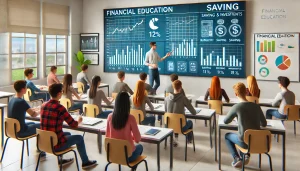In recent years, the spotlight has increasingly shifted towards financial education in schools, marking a significant change in the educational landscape. The growing recognition of the importance of financial literacy is due to the rising concerns over financial instability among young adults. Studies have shown that a lack of financial knowledge can lead to lifelong challenges, including debt and poor financial decisions.
Understanding financial concepts such as budgeting, saving, and investing can drastically improve an individual’s future financial stability. With the rise of global economic interconnectedness, teaching financial literacy is crucial. By incorporating comprehensive financial education programs, schools can ensure students enter adulthood with a strong foundation in financial management.
The current landscape of financial education in the US

Across the United States, several states have started implementing mandatory financial education programs within their public school systems. These changes highlight a national priority to equip students with the financial literacy tools they require. For example, states like Utah and Missouri have been pioneers in introducing comprehensive financial courses as part of their high school curriculum.
Recent educational guidelines have also shifted to include more practical financial topics in their curricula. As a result, more students are learning about the nuances of credit, loans, and investments before leaving school. Data suggests that schools embracing these changes see their students graduating with better preparedness for real-world financial challenges.
Moreover, surveys indicate a positive trend in student engagement and performance in states where these courses have been implemented. Real-life financial skills acquired during these lessons can significantly influence their financial behaviors as adults. These developments not only benefit the students, but also potentially reduce the societal costs associated with financial illiteracy.
Primary reasons for emphasizing financial education
The staggering growth of student and personal debt in the US underscores the urgent need for widespread financial education. An increasing number of young adults find themselves struggling with substantial debt due to lack of financial training. Understanding how to manage loans, credit cards, and taxes is becoming a necessary skill for maintaining financial health.
Helping students navigate the complexities of financial systems also plays a crucial role in reducing economic inequality. By fostering an environment where financial knowledge is accessible to all, schools help bridge the gap between different socioeconomic groups. Financial literacy gives individuals the confidence to pursue economic opportunities they might have previously deemed unreachable.
Furthermore, an emphasis on financial education equips the youth with skills to engage actively in economic systems. With proper knowledge, they can make investments, understand market dynamics, and plan for future financial goals. By intentionally focusing on financial literacy, schools can significantly contribute to a balanced and robust economy.
Long-term benefits of financial education
One of the most notable long-term benefits of financial literacy is enhanced financial stability in adulthood. Individuals who understand how to budget effectively, manage credit responsibly, and save for the future are less prone to financial crises. The knowledge gained from financial education helps in making informed choices that lead to financial wellbeing.
Financial education also encourages the practice of preparing for retirement and making sound investment choices. These skills enable individuals to secure their future and avoid reliance on social safety nets. Moreover, by understanding financial markets, people can participate more actively in economic activities, fostering a culture of saving and investment.
The ripple effects of effective financial education reach beyond individual preparedness. A financially savvy populace is more likely to support and advocate for sound economic policies. As these knowledgeable individuals enter the workforce, they bring with them the ability to make strategic financial decisions.
Challenges and barriers to implementation
Despite the clear benefits, there are significant challenges in implementing financial education across all schools. One major hurdle is the lack of standardized curricula, which can lead to inconsistent teaching quality and coverage of financial concepts.
Additionally, preparing educators to teach such complex subjects presents another significant challenge. Financial education requires training teachers to convey intricate financial principles effectively. This necessity for specialized training imposes additional burdens on educational institutions.
Another obstacle lies in the varying levels of priority given to financial education across different regions. While some states see the value and have embraced this need, others lag in recognizing its importance. Overcoming these disparities requires collective advocacy from educators, parents, and policymakers.
The future evolution of financial education
The future of financial education looks promising, with increasing integration of technology and personal finance apps enhancing learning experiences. Digital tools provide students with interactive and practical knowledge, making financial concepts more accessible and engaging.
As technology continues to evolve, these resources will play an integral role in the future of financial education, bridging gaps in understanding and providing real-time financial management experiences.
Expanding successful programs to all schools nationwide would ensure that every student has equal opportunities to acquire essential financial skills. Strategic partnerships between the government and private sector could further enhance these efforts by bringing additional resources and expertise to educational programs.
Looking ahead, there is significant potential for financial education to become a staple of the American education system. As awareness grows and more stakeholders come together, the path is set for a comprehensive approach to financial literacy that addresses the needs of all students.







